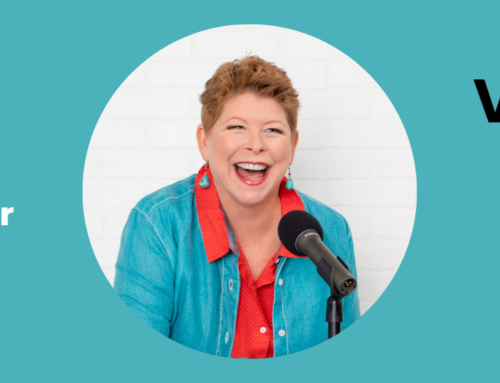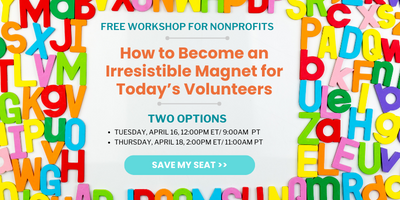
A How to Guide on Leading with Gratitude
Last week, I was the lucky beneficiary of several expressions of gratitude from clients and friends. Their heartfelt thank you notes and intention of leading with gratitude really helped lift my spirits during an otherwise tough week.
Their generosity also got me thinking about the power of gratitude. How might it be harnessed as a strategy to support the emotional health of volunteer teams?
At times leaders of volunteers, like other leaders under stress, feel isolated and unappreciated. We look outside ourselves for validation of our work, and if it isn’t there, we become frustrated.
What if we took direct responsibility for changing the mood and culture of our organizations by becoming more grateful? What if we led with gratitude? Would it make a difference in the effectiveness of our volunteer teams? of our organizations as a whole?
And, if so, how would we get started?
Research has shown that, indeed, gratitude can have a powerful effect on people. It seems particularly suited to volunteerism, a field that is driven by compassion.
Below are some ideas for how gratitude might be tapped for the greater good. What do you think?
Leading with Gratitude is Powerful
Research has shown that gratitude, when practiced consistently, has powerful physical, psychological and emotional effects. Anyone can experience these benefits, no matter what your age or life situation. Among other benefits, gratitude has been shown to build stronger immune systems, lower blood pressure, inspire optimism and happiness, reduce loneliness, and promote generosity. It also blocks toxic emotions because you can’t feel negativity and gratitude at the same time.
Idea in Action: I’ve worked with volunteer teams that just can’t seem to get over their negativity. Although the volunteers’ frustrations may be warranted in some cases, it ends up bringing everyone down and is counterproductive to making positive change. To block this toxicity, try starting each meeting or one-on-one encounter by sharing something you are grateful for. If you do this long enough, it will catch on.
Free Will is the Engine That Powers Gratitude
A belief in the free will of others is what fuels our gratitude. Rather than feeling merely lucky, we feel true gratitude when we believe another person has the option to choose whether or not to help. The greater the sacrifice we recognize in others, the larger the feeling of gratitude.
Idea in Action: I think we all have the tendency to misunderstand or minimize the actual effort it takes for others to help us. Tis is also true for our perceptions of volunteer effort. Imagine what it takes for a volunteer to set aside time in their calendar, clear their volunteer commitment with loved ones, arrange childcare if they are parents, figure out how to drive or commute to the volunteer site, and often sacrifice time that might otherwise be used for more leisure pursuits. It’s a lot to ask, no? So, when we recognize volunteers, we must recognize the entirety of what they had to sacrifice to serve.
If we take time to put ourselves in the shoes of our volunteers, I suspect gratitude for their efforts, as well as ours, will increase exponentially.Instead of complaining that they can’t devote enough time to our organization, we might be better served to be grateful for any contribution of time and effort on behalf of our causes. One of my consulting clients sends thank you notes to spouses of their volunteer leaders, to thank them for “lending” their significant other to the organization. Through this act, they recognize that volunteering impacts the whole family.
Are You Truly Grateful? Take this Gratitude Quiz!
The Greater Good Center at UC Berkeley has a short online quiz. Find out your gratitude score and get helpful suggestions on how to cultivate more gratitude in your life and work.
At Its Best, Gratitude is a Two-Way Street
True gratitude means that we acknowledge our interdependence as well. To be truly transformational, gratitude must be given and received. Gratitude can certainly be expressed. But, if the other person does not, or cannot, fully accept it, it may fall upon deaf ears. Gratitude is, at its core, a collaborative exercise. It’s a social emotion, and its very nature an strengthen relationships.
Idea in Action: Some of us have a hard time accepting thanks, no matter how heartfelt. Due to personality traits, family history, culture, a feeling of obligation, etc., our volunteers may feel uncomfortable with your efforts to recognize them. To keep gratitude flowing, it might help to facilitate a team discussion about gratitude with your volunteers, including an exploration of what might get in the way and why it is helpful to the individual health of each team member and the overall organization.
Gratitude Can be Cultivated
You have the power within you. If you find yourself overstressed or gratitude isn’t your natural default setting, there’s good news for you. Gratitude can be consciously cultivated.
Idea in Action: By being mindful about what you’re grateful for – for example, counting your blessings on a consistent basis, writing in a gratitude journal, being grateful for the opportunity to both give and receive and using grateful language – you can develop a more grateful and happy self. The mindful acknowledgment of things we’re grateful for, in these or other ways, can become part of a volunteer team’s regular rituals.
Expressing gratitude isn’t always easy. It requires us to be vulnerable and persistent in the face of pervasive negativity. It sometimes means that we are the sole voice amidst a culture of entitlement.
But, the focus on acknowledging others has real benefits beyond the fulfillment of a social contract. Research tells us it can be transformational, helping us not only survive but also thrive.
Have You Seen the Power of Gratitude in Action?
How did it transform the situation? Share what happened in the comments below.








Leave A Comment